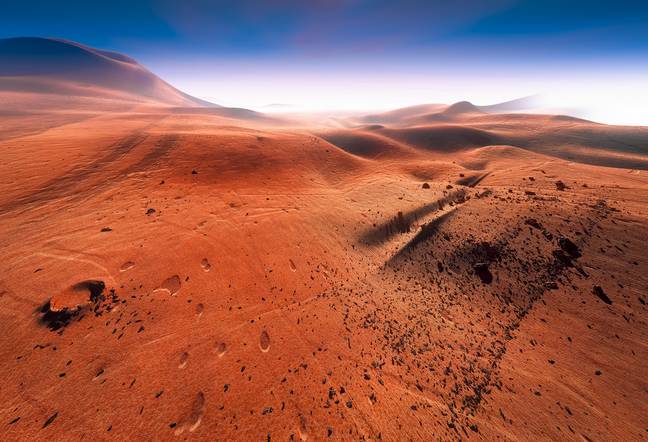NASA believes it has found signs of life on Mars after its Curiosity rover brought back supporting evidence.
Rocks collected by the rover and reviewed by NASA contain organic carbon, which could potentially have come from bugs that previously lived on Mars.
*Cue David Bowie’s ‘Life on Mars’*
NASA analysed sediment from six different locations the rover had explored and found an ancient carbon cycle.
Plrang GFX / Alamy Stock Photo
The samples could have a ‘biological basis’, according to NASA, and resemble fossilised remains of microbial life that have been found in Australia.
Professor Christopher House, the lead author of the study from Penn State University in the US, told The Metro: “The samples extremely depleted in carbon 13 are a little like samples from Australia taken from sediment that was 2.7 billion years old.”
“Those samples were caused by biological activity when methane was consumed by ancient microbial mats. But we can’t necessarily say that on Mars because it’s a planet that may have formed out of different materials and processes than Earth.”
S.E.A. Photo / Alamy Stock Photo
On Earth, it would indicate the microbes consumed microbially-produced methane, which is the simplest organic molecule and is present in Mars’ atmosphere.
On Mars, it means that large plumes of methane could have been being released from the subsurface, where production would have been energetically favourable.
The released methane would then either be consumed by microbes or react with ultraviolet light before being deposited directly on the surface.
Exploration on Mars has been focused around the Gale Crater which is believed to have once been a deep lake 3.5 billion years ago.
It’s thought the crater may contain complex organic molecules that are key raw materials to sustain life.
dotted zebra / Alamy Stock Photo
House said: “The amounts of carbon 12 and carbon 13 in our solar system are the amounts that existed at the formation of the solar system.
Both exist in everything, but because carbon 12 reacts more quickly than carbon 13, looking at the relative amounts of each in samples can reveal the carbon cycle.”
Carbon has two stable isotopes – 12 and 13 – and the amounts of these give an insight into its origin.
The rover heated both samples to separate the chemicals and scans showed some of them were depleted in 13 while others were enriched.
This could be a result of other factors, including cosmic dust clouds or ultraviolet radiation which would break down carbon dioxide.
“All three of these scenarios are unconventional – unlike processes common on Earth,” concluded House.
 Moni Malawi
Moni Malawi 

